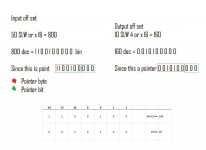Matchu04
Lifetime Supporting Member
Evening all, I have got a program that I am trying to get my barnit around but wanted to clarify with someone with a lot more experience than my self.
I am having trouble trying to understand the FC316. From what I can gather MW100 is 2 bytes of bits that depending on the configuration determines the output word MW102. FC316 is a 40 word sequencer that evaluates that word at each step.
My questions...
Am I right in thinking that in FC316 the reference part is from LAR 1, as it is using the current db location??
Why at the start of FC316 is it SLW 4, I can see what that achieves??
When FC316 is first called DB100 is opened, how do I go about finding the correct sequence for each step as DB100 does not have 40 steps in it..
I appreciate that there is a lot here guys but I would be so grateful for the help..
I am having trouble trying to understand the FC316. From what I can gather MW100 is 2 bytes of bits that depending on the configuration determines the output word MW102. FC316 is a 40 word sequencer that evaluates that word at each step.
My questions...
Am I right in thinking that in FC316 the reference part is from LAR 1, as it is using the current db location??
Why at the start of FC316 is it SLW 4, I can see what that achieves??
When FC316 is first called DB100 is opened, how do I go about finding the correct sequence for each step as DB100 does not have 40 steps in it..
I appreciate that there is a lot here guys but I would be so grateful for the help..



